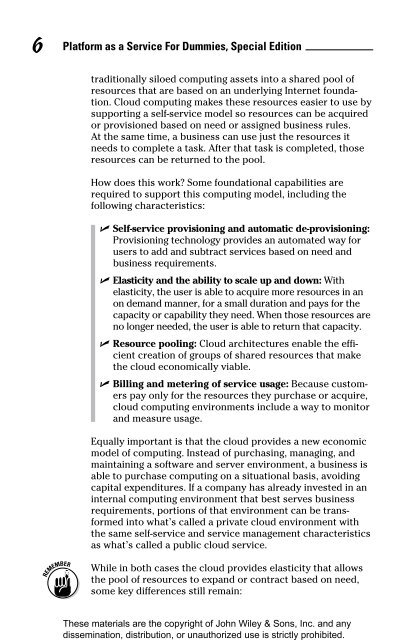u3Zgz
u3Zgz
u3Zgz
You also want an ePaper? Increase the reach of your titles
YUMPU automatically turns print PDFs into web optimized ePapers that Google loves.
These materials are the copyright of John Wiley & Sons, Inc. and any<br />
dissemination, distribution, or unauthorized use is strictly prohibited.<br />
6<br />
Platform as a Service For Dummies, Special Edition<br />
traditionally siloed computing assets into a shared pool of<br />
resources that are based on an underlying Internet foundation.<br />
Cloud computing makes these resources easier to use by<br />
supporting a self-service model so resources can be acquired<br />
or provisioned based on need or assigned business rules.<br />
At the same time, a business can use just the resources it<br />
needs to complete a task. After that task is completed, those<br />
resources can be returned to the pool.<br />
How does this work Some foundational capabilities are<br />
required to support this computing model, including the<br />
following characteristics:<br />
✓ Self-service provisioning and automatic de-provisioning:<br />
Provisioning technology provides an automated way for<br />
users to add and subtract services based on need and<br />
business requirements.<br />
✓ Elasticity and the ability to scale up and down: With<br />
elasticity, the user is able to acquire more resources in an<br />
on demand manner, for a small duration and pays for the<br />
capacity or capability they need. When those resources are<br />
no longer needed, the user is able to return that capacity.<br />
✓ Resource pooling: Cloud architectures enable the efficient<br />
creation of groups of shared resources that make<br />
the cloud economically viable.<br />
✓ Billing and metering of service usage: Because customers<br />
pay only for the resources they purchase or acquire,<br />
cloud computing environments include a way to monitor<br />
and measure usage.<br />
Equally important is that the cloud provides a new economic<br />
model of computing. Instead of purchasing, managing, and<br />
maintaining a software and server environment, a business is<br />
able to purchase computing on a situational basis, avoiding<br />
capital expenditures. If a company has already invested in an<br />
internal computing environment that best serves business<br />
requirements, portions of that environment can be transformed<br />
into what’s called a private cloud environment with<br />
the same self-service and service management characteristics<br />
as what’s called a public cloud service.<br />
While in both cases the cloud provides elasticity that allows<br />
the pool of resources to expand or contract based on need,<br />
some key differences still remain:


